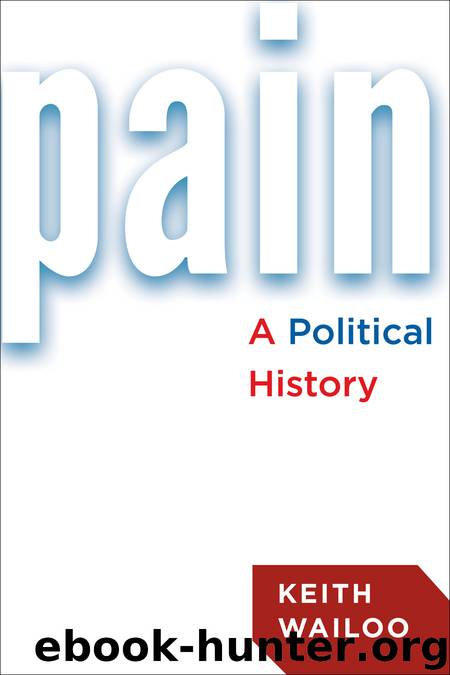Pain by Keith Wailoo

Author:Keith Wailoo
Language: eng
Format: epub
Publisher: Johns Hopkins University Press
Published: 2014-06-27T16:00:00+00:00
Ultimate Relief: The Supreme Court, Oregon, and Death with Dignity
The PAS debate became to 1990s cultural politics what abortion had been two decades earlier, but where abortion mostly unified right and left against one another, PAS was a more fractious issue within each political party. On this topic, the Religious Right parted company with small government conservatives, and disability rights advocates split from the mainstream Left. For the courts, PAS also became a major test of citizens’ constitutional rights, raising new questions similar to the way privacy rights and abortion rights were conjoined.26 As the courts looked closely at PAS, an entirely new legal and constitutional terrain came into view: Was medically induced death a constitutional right? Was it legally acceptable as a corollary to aggressive relief? Did doctors have a moral obligation or a legal duty to relieve pain? If the line between pain relief and euthanasia was unclear medically, could the law draw the distinction any more clearly? And what level of government should make such relief policies—the Congress, state legislatures, the people of Oregon? These were among the major constitutional questions that now spiraled off from the new practices of pain relief.
Because divisions across the states on pain policies were so profound, a crucial issue before the federal courts concerned not only the individual’s right to self-relief but also federalism. Could each state chart its own course in such matters, or should national law claim precedence?27 Was there such a thing as a constitutional right to pain relief, akin perhaps to the right to privacy that the liberal Burger court had endorsed in Roe v. Wade? What began as trials of a few outlandish doctors soon raised the possibility that pain relief might actually be an American right—and such a question could only be ruled upon in the higher courts.
Beyond Kevorkian in Michigan, liberal-leaning West Coast states were having a profound impact on relief politics. In Washington, Oregon, and California, popular democracy movements pushed these three diverse states to establish new rights in flagrant opposition to the federal government—particularly with regard to the use of drugs to bring relief. In 1988 the California-based Americans against Human Suffering attempted (but failed) to place a PAS bill on the ballot—the first attempt in the United States to legalize assisted suicide through a referendum. Four years later, in 1992, California advocates succeeded in getting the initiative (Proposition 161) on the ballot. But that November voters rejected it. Oregon advocates then took up the challenge, putting their own death with dignity law before the voters in 1994. It allowed physicians to prescribe, but not to administer, lethal doses of drugs for patients who had less than six months to live, who had been deemed mentally competent, and who chose death voluntarily in front of witnesses. Also on the ballot in 1994 was a gubernatorial race featuring legislator and physician John Kitzhaber—who had helped establish the Oregon Health Plan—as the leading candidate. His election by a 51 percent vote mirrored the outcome on the PAS referendum (also 51 percent).
Download
This site does not store any files on its server. We only index and link to content provided by other sites. Please contact the content providers to delete copyright contents if any and email us, we'll remove relevant links or contents immediately.
| Anthropology | Archaeology |
| Philosophy | Politics & Government |
| Social Sciences | Sociology |
| Women's Studies |
The Secret History by Donna Tartt(18846)
The Social Justice Warrior Handbook by Lisa De Pasquale(12141)
Thirteen Reasons Why by Jay Asher(8794)
This Is How You Lose Her by Junot Diaz(6794)
Weapons of Math Destruction by Cathy O'Neil(6143)
Zero to One by Peter Thiel(5686)
Beartown by Fredrik Backman(5597)
The Myth of the Strong Leader by Archie Brown(5425)
The Fire Next Time by James Baldwin(5249)
How Democracies Die by Steven Levitsky & Daniel Ziblatt(5128)
Promise Me, Dad by Joe Biden(5087)
Stone's Rules by Roger Stone(5026)
A Higher Loyalty: Truth, Lies, and Leadership by James Comey(4843)
100 Deadly Skills by Clint Emerson(4840)
Rise and Kill First by Ronen Bergman(4703)
Secrecy World by Jake Bernstein(4646)
The David Icke Guide to the Global Conspiracy (and how to end it) by David Icke(4625)
The Farm by Tom Rob Smith(4435)
The Doomsday Machine by Daniel Ellsberg(4416)
